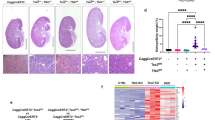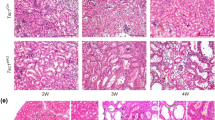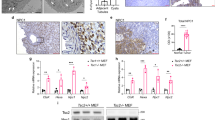Abstract
Tuberin, a tumor-suppressor protein produced by the tuberous sclerosis gene TSC2, downregulates the Rheb-mTOR-S6K pathway (mTOR axis). Comparison of the effects of human tuberin mutations, such as G1556S, suggests that pathways other than the mTOR axis might also be involved in the pathogenesis of tuberous sclerosis. Here we test this possibility using the rat G1556S-type mutation (GSM) and a transgenic Eker (Tsc2 mutant) rat system. Cells expressing GSM-tuberin failed to downregulate the mTOR axis. GSM-tuberin had an altered localization, which underlie its reduced ability to form a complex with hamartin, and a site-specific alteration in phosphorylation status indicating diverse regulation by Akt. GSM-transgenic (GSM-Tg) rats exhibited suppression of macroscopic renal tumors following N-ethyl-N-nitrosourea treatment. Intriguingly, rats with weaker GSM-Tg expression showed microscopic cystic and pre-tumorous lesions that were restricted in size and expansion, although they had hyper-phosphorylation of ribosomal protein S6. These results highlight a novel pathway involving tuberin that regulates tumor suppression independently of the mTOR inhibitory function. Identification of such a novel pathway will provide clear implications for generation of new therapeutic targets in the treatment of these tumors.
This is a preview of subscription content, access via your institution
Access options
Subscribe to this journal
Receive 50 print issues and online access
$259.00 per year
only $5.18 per issue
Buy this article
- Purchase on Springer Link
- Instant access to full article PDF
Prices may be subject to local taxes which are calculated during checkout




Similar content being viewed by others
References
Aicher LD, Campbell JS, Yeung RS . (2001). Tuberin phosphorylation regulates its interaction with hamartin. Two proteins involved in tuberous sclerosis. J Biol Chem 276: 21017–21021.
Astrinidis A, Henske EP . (2005). Tuberous sclerosis complex: linking growth and energy signaling pathways with human disease. Oncogene 24: 7475–7481.
Bissler JJ, McCormack FX, Young LR, Elwing JM, Chuck G, Leonard JM et al. (2008). Sirolimus for angiomyolipoma in tuberous sclerosis complex or lymphangioleiomyomatosis. N Engl J Med 358: 140–151.
Dan HC, Sun M, Yang L, Feldman RI, Sui XM, Ou CC et al. (2002). Phosphatidylinositol 3-kinase/Akt pathway regulates tuberous sclerosis tumor suppressor complex by phosphorylation of tuberin. J Biol Chem 277: 35364–35370.
Dancey JE, Chen HX . (2006). Strategies for optimizing combinations of molecularly targeted anticancer agents. Nat Rev Drug Discov 5: 649–659.
Davies DM, Johnson SR, Tattersfield AE, Kingswood JC, Cox JA, McCartney DL et al. (2008). Sirolimus therapy in tuberous sclerosis or sporadic lymphangioleiomyomatosis. N Engl J Med 358: 200–203.
Easton JB, Houghton PJ . (2006). mTOR and cancer therapy. Oncogene 25: 6436–6446.
Eker R, Mossige J . (1961). A dominant gene for renal adenomas in the rat. Nature 189: 858–859.
Fabian MA, Biggs III WH, Treiber DK, Atteridge CE, Azimioara MD, Benedetti MG et al. (2005). A small molecule-kinase interaction map for clinical kinase inhibitors. Nat Biotechnol 23: 329–336.
Faivre S, Kroemer G, Raymond E . (2006). Current development of mTOR inhibitors as anticancer agents. Nat Rev Drug Discov 5: 671–688.
Franz DN, Leonard J, Tudor C, Chuck G, Care M, Sethuraman G et al. (2006). Rapamycin causes regression of astrocytomas in tuberous sclerosis complex. Ann Neurol 59: 490–498.
Fukuda T, Hirayama Y, Mitani H, Maeda H, Tsutsumi M, Konishi Y et al. (1998). Generation of metastatic variants of Eker renal carcinoma cell lines for experimental investigation of renal cancer metastasis. Jpn J Cancer Res 89: 1104–1108.
Gomez MR, Sampson JR, Whittemore VH . (1999). Tuberous Sclerosis Complex. Oxford University Press: New York.
Granville CA, Memmott RM, Gills JJ, Dennis PA . (2006). Handicapping the race to develop inhibitors of the phosphoinositide 3-kinase/Akt/mammalian target of rapamycin pathway. Clin Cancer Res 12: 679–689.
Guertin DA, Sabatini DM . (2007). Defining the role of mTOR in cancer. Cancer Cell 12: 9–22.
Hino O, Klein-Szanto AJ, Freed JJ, Testa JR, Brown DQ, Vilensky M et al. (1993a). Spontaneous and radiation-induced renal tumors in the Eker rat model of dominantly inherited cancer. Proc Natl Acad Sci USA 90: 327–331.
Hino O, Kobayashi T, Tsuchiya H, Kikuchi Y, Kobayashi E, Mitani H et al. (1994). The predisposing gene of the Eker rat inherited cancer syndrome is tightly linked to the tuberous sclerosis (TSC2) gene. Biochem Biophys Res Commun 203: 1302–1308.
Hino O, Mitani H, Knudson AG . (1993b). Genetic predisposition to transplacentally induced renal cell carcinomas in the Eker rat. Cancer Res 53: 5856–5858.
Inoki K, Li Y, Zhu T, Wu J, Guan KL . (2002). TSC2 is phosphorylated and inhibited by Akt and suppresses mTOR signalling. Nat Cell Biol 4: 648–657.
Jansen AC, Sancak O, D'Agostino MD, Badhwar A, Roberts P, Gobbi G et al. (2006). Unusually mild tuberous sclerosis phenotype is associated with TSC2 R905Q mutation. Ann Neurol 60: 528–539.
Kenerson H, Dundon TA, Yeung RS . (2005). Effects of rapamycin in the Eker rat model of tuberous sclerosis complex. Pediatr Res 57: 67–75.
Kenerson HL, Aicher LD, True LD, Yeung RS . (2002). Activated mammalian target of rapamycin pathway in the pathogenesis of tuberous sclerosis complex renal tumors. Cancer Res 62: 5645–5650.
Kobayashi T, Adachi H, Mitani H, Hirayama Y, Hino O . (2003). Toward chemotherapy for Tsc2 mutant renal tumor. Proc Jpn Acad 79: 22–25.
Kobayashi T, Hirayama Y, Kobayashi E, Kubo Y, Hino O . (1995). A germline insertion in the tuberous sclerosis (Tsc2) gene gives rise to the Eker rat model of dominantly inherited cancer. Nat Genet 9: 70–74.
Kobayashi T, Mitani H, Takahashi R, Hirabayashi M, Ueda M, Tamura H et al. (1997). Transgenic rescue from embryonic lethality and renal carcinogenesis in the Eker rat model by introduction of a wild-type Tsc2 gene. Proc Natl Acad Sci USA 94: 3990–3993.
Kwiatkowski DJ, Zhang H, Bandura JL, Heiberger KM, Glogauer M, el-Hashemite N et al. (2002). A mouse model of TSC1 reveals sex-dependent lethality from liver hemangiomas, and up-regulation of p70S6 kinase activity in Tsc1 null cells. Hum Mol Genet 11: 525–534.
Lee L, Sudentas P, Dabora SL . (2006). Combination of a rapamycin analog (CCI-779) and interferon-gamma is more effective than single agents in treating a mouse model of tuberous sclerosis complex. Genes Chromosomes Cancer 45: 933–944.
Lee L, Sudentas P, Donohue B, Asrican K, Worku A, Walker V et al. (2005). Efficacy of a rapamycin analog (CCI-779) and IFN-gamma in tuberous sclerosis mouse models. Genes Chromosomes Cancer 42: 213–227.
Li Y, Corradetti MN, Inoki K, Guan KL . (2004). TSC2: filling the GAP in the mTOR signaling pathway. Trends Biochem Sci 29: 32–38.
Manning BD, Cantley LC . (2003). Rheb fills a GAP between TSC and TOR. Trends Biochem Sci 28: 573–576.
Manning BD, Tee AR, Logsdon MN, Blenis J, Cantley LC . (2002). Identification of the tuberous sclerosis complex-2 tumor suppressor gene product tuberin as a target of the phosphoinositide 3-kinase/akt pathway. Mol Cell 10: 151–162.
Martin DE, Hall MN . (2005). The expanding TOR signaling network. Curr Opin Cell Biol 17: 158–166.
Mayer K, Goedbloed M, van Zijl K, Nellist M, Rott HD . (2004). Characterisation of a novel TSC2 missense mutation in the GAP-related domain associated with minimal clinical manifestations of tuberous sclerosis. J Med Genet 41: e64.
Momose S, Kobayashi T, Mitani H, Hirabayashi M, Ito K, Ueda M et al. (2002). Identification of the coding sequences responsible for Tsc2-mediated tumor suppression using a transgenic rat system. Hum Mol Genet 11: 2997–3006.
Nellist M, Sancak O, Goedbloed MA, Rohe C, van Netten D, Mayer K et al. (2005). Distinct effects of single amino-acid changes to tuberin on the function of the tuberin-hamartin complex. Eur J Hum Genet 13: 59–68.
Nellist M, Verhaaf B, Goedbloed MA, Reuser AJ, van den Ouweland AM, Halley DJ . (2001). TSC2 missense mutations inhibit tuberin phosphorylation and prevent formation of the tuberin-hamartin complex. Hum Mol Genet 10: 2889–2898.
Niida Y, Lawrence-Smith N, Banwell A, Hammer E, Lewis J, Beauchamp RL et al. (1999). Analysis of both TSC1 and TSC2 for germline mutations in 126 unrelated patients with tuberous sclerosis. Hum Mutat 14: 412–422.
O'Reilly KE, Rojo F, She QB, Solit D, Mills GB, Smith D et al. (2006). mTOR inhibition induces upstream receptor tyrosine kinase signaling and activates Akt. Cancer Res 66: 1500–1508.
Shah OJ, Hunter T . (2004). Critical role of T-loop and H-motif phosphorylation in the regulation of S6 kinase 1 by the tuberous sclerosis complex. J Biol Chem 279: 20816–20823.
Sun GD, Kobayashi T, Abe M, Tada N, Adachi H, Shiota A et al. (2007). The endoplasmic reticulum stress-inducible protein Niban regulates eIF2alpha and S6K1/4E-BP1 phosphorylation. Biochem Biophys Res Commun 360: 181–187.
Yeung RS, Xiao GH, Jin F, Lee WC, Testa JR, Knudson AG . (1994). Predisposition to renal carcinoma in the Eker rat is determined by germ-line mutation of the tuberous sclerosis 2 (TSC2) gene. Proc Natl Acad Sci USA 91: 11413–11416.
Acknowledgements
This research was supported by a Grant-in-aid for Cancer Research from the Ministry of Education, Culture, Sports, Science and Technology and Grants-in-Aid for Scientific Research from Japan Society for the Promotion of Science and the Ministry of Health, Labour and Welfare of Japan. We also thank Ms N Otsuji (Department of Pathology and Oncology), Mr R Tsukada, Mr F Kanai, Ms T Hidano (Center for Biomedical Research Resources), Mr M Yoshida, Mr J Nakamoto (Division of Ultrastructural Research), Mr Y Watanabe, Mr K Matsunami, Ms K Ochiai (Division of Radioisotope Research), Dr T Fujimura (Division of Proteomics and BioMolecular Science), Ms Y Kojima, Dr H Kurihara (Division of Biomedical Imaging Research), Dr T Seki (Department of Developmental Neurobiology), Dr T Ueno and Dr E Kominami (Department of Biochemistry), all of Juntendo University, for their support.
Author information
Authors and Affiliations
Corresponding author
Additional information
Supplementary Information accompanies the paper on the Oncogene website (http://www.nature.com/onc)
Supplementary information
Rights and permissions
About this article
Cite this article
Shiono, M., Kobayashi, T., Takahashi, R. et al. The G1556S-type tuberin variant suppresses tumor formation in tuberous sclerosis 2 mutant (Eker) rats despite its deficiency in mTOR inhibition. Oncogene 27, 6690–6697 (2008). https://doi.org/10.1038/onc.2008.283
Received:
Revised:
Accepted:
Published:
Issue Date:
DOI: https://doi.org/10.1038/onc.2008.283



